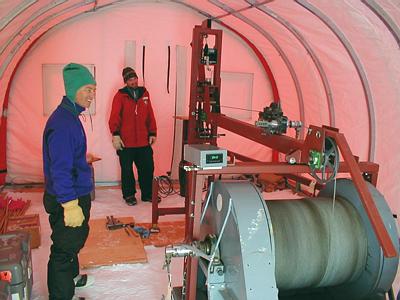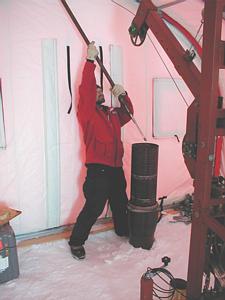24 November, 2000
Logging in Antarctica
Normally, one wouldn't think of logging as an activity you would engage in on an ice sheet in Antarctica. In this case it has nothing to do with cutting down trees. Logging also refers to using an instrument to collect a series of data, usually below the surface of the ground, water, or ice. Today, Gary Clow and Bob Hawley are conducting the first temperature log of the main borehole.
Collecting precise temperature data from a 1000-meter hole in the ice requires specialized equipment and instruments. A two-ton winch is used to lower the temperature probe and cable down the hole. The cable contains four wires that make two electrical circuits. When one circuit reaches the temperature probe, it passes through three parallel packets of thermistor beads. The electrical resistance of these silicon alloy beads varies with temperature. The lower the temperature, the greater the resistance will be, causing a drop in the voltage. The temperature can be calculated by measuring the voltage difference between the two circuits.
The actual logging procedure is a painstaking operation. The probe is lowered down the hole at about three meters a minute. At that rate it takes about five hours to reach the bottom. The electronics are contained in a temperature controlled "hot box." Temperature data is recorded every two seconds during which time the probe moves down 10 cm (4 in). To avoid any static or noise in the data, the area must be clear of electronic devices as well as any movement such as high winds or people walking around. The single operator stands still watching the winch. Gary and Bob are taking turns in two-hour shifts.

A. Gary and Bob are admiring the winch that they assembled next to the borehole. The winch had to be moved into place with a forklift. The winch and borehole are inside a temporary structure called a weatherport.

B. Looking a bit like a whaler with a harpoon, Bob maneuvers the end of the cable with the temperature probe into the borehole casing. A fluid called N-butyl acetate fills all but the top fifty meters of the hole.

C. The red weatherport houses the borehole and winch. The logging electronics are in the yellow tent. The square orange building holds the diesel generator. The green weatherport is used for storage and as a shelter from the weather. The field camp appears in the far distance on the right side of the image.
Contact the TEA in the field at
.
If you cannot connect through your browser, copy the
TEA's e-mail address in the "To:" line of
your favorite e-mail package.
|
